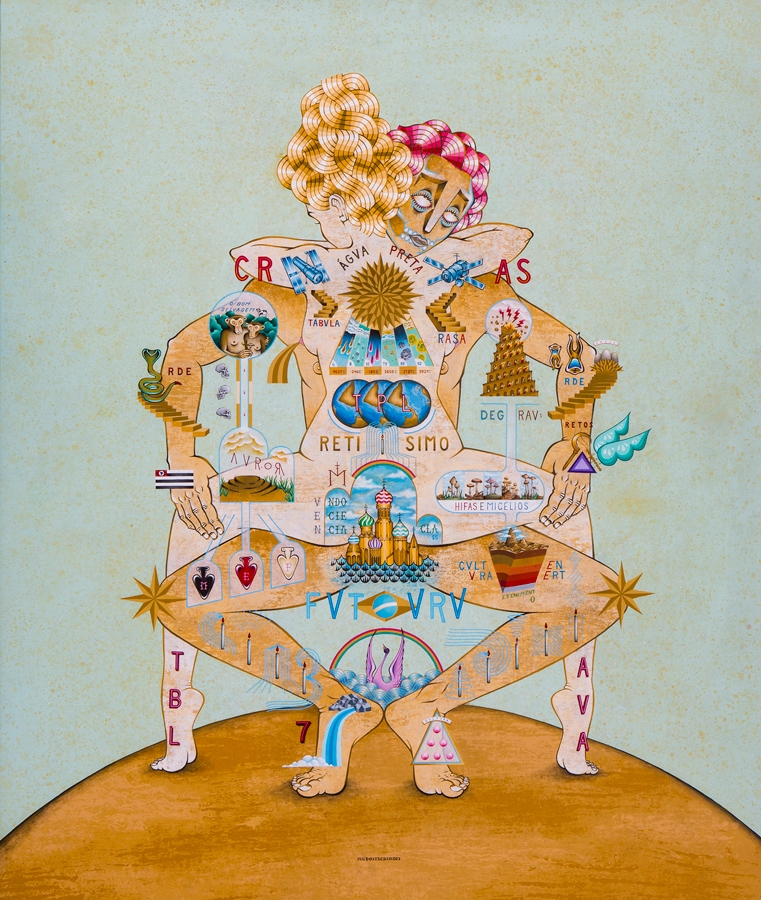Stephan Doitschinoff is a man with a message – or, rather, lots of messages. They’re spelled out in a lexicon of symbols that appear over and over in his work, clustered like nebulae around the mournful mortals in his paintings. They orbit a sun-headed man in O Sol (2013) as a pair of crowned swans hovering at his chest, a cobra at his solar plexus and a clutch of Orthodox steeples gathered at his groin. In Água Preta (2013), a man and a woman are locked together, a waterfall gushing from her heel while twin satellites spin at his shoulders; and in Emergência (2013), a bee is swarmed by a dozen or more icons, from stars, globes and bleeding hearts to a constellation of psychoactive plants including peyote, psilocybin and morning glory.
Doitschinoff must be one of the most heavily tattooed artists in São Paulo. That is, we don’t know how many tattoos, if any, his own skin harbours; but his iconography has found a home on the bodies of dozens of his admirers, inked out on chests, shins, shoulders and arms in a gallery of images that can be seen on his Facebook page, featuring more than 100, and counting. Jungian in their insistence that we consider the symbol, just contemplate it, his icons, many of which figure repeatedly in his paintings, are as universal, simple and enigmatic as Mexican lotería cards – Babel in flames, the heart spilling forth, the calavera; but they also bristle with impenetrable, carefully lettered acronyms and arcane references.
The fruit of years of research into religious art, mythology and Brazilian folk art, the paintings in this exhibition were made during Doitschinoff’s return to the village of Len.o.s in northeast Brazil last year, where he had previously lived for the best part of three years, and where he eventually painted the exteriors of a number of his neighbours’ houses with his self-taught brand of quasi-religious imagery. On the wattle-and-daub walls of some of the poorest homes in the village – which was once at the heart of Brazil’s diamond-mining trade – churches drown in a sea of troubles and a man lies prone, a tree growing from his chest and diamonds rising from his guts. In the ‘semimedieval atmosphere’ of Lençoís, as Doitschinoff has described it, the images’ roots in Brazilian traditional art and sacred art seem to take them full circle, and the murals, documented in photographs in Doitschinoff’s 2008 book CALMA, become folk art themselves.
The meanings in Doitschinoff’s insistent messages are there for the taking in his writings – in CALMA and in CRAS, his 2012 book of modern illuminated manuscripts, paintings and texts, in which he explains some of his symbols (e.g. the Tower of Babel in flames as the exhaustion of globalisation: ‘We have consumed everything’). Occasionally, a symbol jars or feels a little didactic – the S.o Paulo state flag at the man’s wrist in Água Preta; and the meshing of Doitschinoff’s boldly graphical style with more gently painted tableaux, inserted into the canvases like little dreams, as with a pair of mushroom-eating apes, also in Água Preta, doesn’t always pay off. The rest of the time, sheer contemplation of the paintings – of their cool aquas and ambers, of the lovely planes of the painted waterfalls and the interlocking locks of the women’s hair, and of the soulful faces of their human figures, rich with pity and sorrow – quietly delivers its own message.
This article was originally published in the March 2014 issue.
